Travel Off-the-Beaten Path in Australia
Falling in Love With Lightning Ridge
Story and photos by Nora Dunn
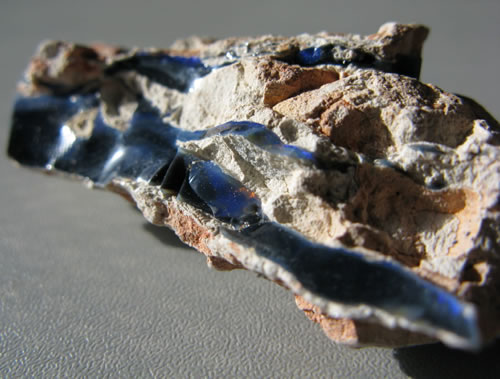
|
|
Raw Opal from a mine in Lightning Ridge, Australia.
|
You would miss Lightning Ridge on an Australian map if you weren't first looking for it, and then shown exactly where it is. But as one of the only places in the world to find black opals, it attracts a collection of characters that make much more of this flat drab track of land than meets the eye.
My boyfriend and I had a burning desire to go to Lightning Ridge as part of our Australian camper van trip. Not only did it scream of the remoteness and beauty of the outback we longed to see, but with the world’s largest seam of the rare and prized black opal running through the area, this was a chance to visit a very unique place. Being renowned for its frontier spirit and “strikingly imaginative mining community” (per Lonely Planet), I had to see for myself what other oxymoronic characteristics it held.
In typical Aussie fashion, Lightning Ridge was aptly named in the 1960s when a drover and his flock of sheep were struck by lightning. The remainder of this town of 2,000 people is made up of a rich variety of eccentric and friendly people — from hopeful prospectors to artisans to “true-blue bushies and the general unconventional collective,” as the guide states.
So imagine our disappointment when we rolled in after a long drive on a Monday afternoon and decided that we would leave the following day. I was terribly disenchanted; tacky billboards advertising opal mines and various opal paraphernalia lined the only road in and out of town. The streets were barren, and we felt out of place. The billboards looked so old and surreal that we wondered if the attractions in question were even still running; it was like we had just discovered a long-abandoned ghost town.
|
Lightning Ridge Was Founded on Black Opals
Opal mining was originally the industry that founded Lightning Ridge, but now most of the active opal mines are about 50kms (30 miles) away. Once the majority of the opal had been mined from Lightning Ridge, all that remained were abandoned piles of rubble (known as fossick heaps), empty mine shafts, and a town infrastructure to support miners who had moved on to richer plots.
The townspeople, left with a depleted mining income that wasn’t enough, tapped into their resources to develop new streams of income and industry. Soon enough, mining dollars were replaced with tourist dollars, and Lightning Ridge survived.
|
In an attempt to drown our sorrows and pass the time away until we left the following morning, we pulled up to the bar at the local Bowling Club. Here, and by pure chance, we met a variety of local characters that enticed us to stay in Lightning Ridge for a week instead of a day, and helped us to see this sleepy town in a new way.
Christine was the first beacon of light on this dreary evening. With a curious smile, she invited us to join her local Rotary meeting in the adjacent room, which this week was simply an informal night and social dinner. Minutes later, we had an invitation to stay in the empty apartment behind her house for as long as we wished. Her generosity abounded, with home-cooked dinners, fresh fruit from the backyard, and an open invitation to stay as long as we wished, even after she left town herself for a few days.
Christine works as a nurse in the nearby state of Queensland and battles an hour’s time zone difference in addition to the commute. Although she likes the quiet remoteness of Lightning Ridge, she misses her children, who are fully grown with kids of their own.
“You have to really WANT to come here,” Christine said of Lightning Ridge. “We aren’t on the way to or from anything, and we’re a full day’s drive from the nearest major airport. Even a quick visit can take days of traveling each way.” Despite not seeing her family as much as she wishes, Christine acknowledges that the drawbacks of Lightning Ridge’s remoteness are conversely what make it appealing. “My husband refused to leave as soon as we got here. It was inexplicably home for him, and it still is twenty years later.”
Getting to Lightning Ridge
Located off the Castlereagh Highway in the northwest corner of New South Whales, Lightning Ridge requires wheels and an intentional desire to get there. It is about 750kms from both Brisbane and Sydney, and is serviced by the NSW TrainLink system. The nearest town of Walgett is 75kms (45 miles) away, and is not much to look at with little more than the bare essentials.
Weather: When to Go
Lightning Ridge is temperate in winter, with highs around 22 degrees Celsius and some evenings requiring a fire to be cozy. Summertime can be extremely hot and some locals live elsewhere for the hottest months (November-March). The best time to go is generally in the spring and autumn seasons.
|
Gale and Roger were the next people to brighten our day. Gale is an American business woman who met and fell in love with Roger (originally from the UK, and also in big business) in Sydney. On a vacation together to Lightning Ridge, they left with much more than they had anticipated: they had bought a house and museum.
The house was far from just any house: it was hand-made with bottles and other locally sourced trinkets by an elderly woman whose life was quite a story. Gale and Roger took over this house and museum — called The Black Queen — and have made it their own, with a 3-act theater show that is unique. We spent more than a few evenings with Gale and Roger in their beautiful and bizarre home, enjoying their company and listening to their stories.
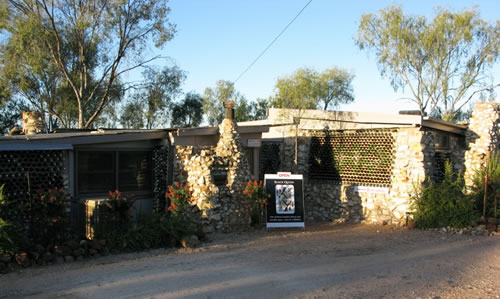
|
|
The Black Queen — a house and museum owned by Gale and Roger.
|
|
Annual Festivals
Timing your visit to major festivals can be a great way to see the area.
MARCH/APRIL: The Lightning Ridge Easter Festival has run for more than 30 years, and culminates with the bizarre Lightning Ridge Great Goat Race. Get a goat (you can purchase one for $50 if you don’t happen to have a goat handy), enter it in the race, and bet on the winner. The festival also features wheelie bin races, horse races, rodeo events, buskers, street stalls, fireworks, live music, and arts and crafts.
JULY: The Lightning Ridge Opal Festival is held at the end of July each year. The 4-day event provides miners, jewelers, buyers, and opal enthusiasts with valuable market insight. It is free to attend, and the collection of gems is noteworthy.
SEPTEMBER: The Lightning Ridge Police Bush Safari is a 2-week, 4-wheel, 3,600km (2,200 miles) adventure to Birdsville and back that doubles as a charity fundraiser. It is held at the end of September each year, and has run for almost 20 years.
|
A few days after our arrival and decision to stay for a while, our reputation preceded us. Our Canadian accents were a giveaway to the locals that we were indeed the young couple spoken about in their latest gossip session. (Once you know one person in a small town like Lightning Ridge, the rest follows suit quickly). So no introduction was necessary as Peter the jeweler raced out of his shop and flagged us down.
Jewelers in Lightning Ridge are a dime a dozen. It is a perfect middle-man position: giving miners a place to sell their raw gems, and tourists a place to buy finished pieces of unique black opal jewelry.
Peter, like so many prospectors who initially came to Lightning Ridge in its heyday, got “opal fever” and spent countless months underground in his mining plots. Although he found opal here and there, he never found the big payload (which is still rumored to exist). When the un-mined plots dwindled, Peter — like many Lightning Ridge residents — was forced to find a new line of work. “I much prefer working with opal than trying to find it,” Peter says of his re-engineered career. His wife crafts jewelry settings, and he prepares the stones and makes most of the sales. Competition between jewelers is steep and ruthless, but since everybody knows each other well, there is a spirit of camaraderie to it that makes the over-population of jewelers in Lightning Ridge more comical than critical.
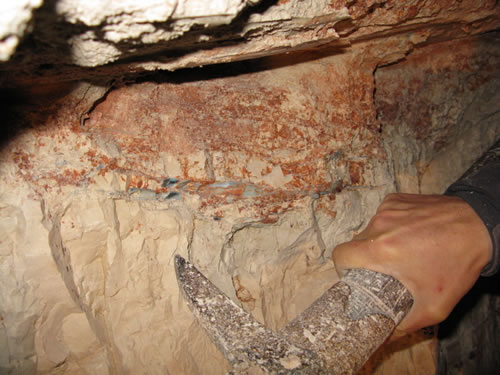
|
|
A seam of raw opal will give the heartiest Opal Fever..
|
Attractions in Lightning Ridge
Here are just a few Lightning Ridge attractions that might capture your imagination:
Car Door Tours: This is a series of scenic educational self-drive tours in the area that have been designed by locals. Route markers are made of colorfully painted old car doors. Information and maps can be found at the Visitor Information Centre.
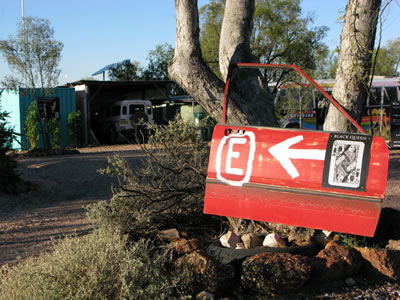
|
|
Car Door Tours.
|
John Murray Art Gallery: John Murray is an outback artist, and he captures the imagination and character of Lightning Ridge and its creatures in his work. He is known for his cartoon-like impressions of emus.
Artesian Bore Baths: This therapeutic hot artesian water pool is free, and open 24 hours a day. It is the perfect way to start off your day with a kick, or to finish it off while relaxing under the stars.
The Grawin Opal Field: Located within driving distance of Lightning Ridge is The Grawin, where most of the area’s active opal mining is done. The locals (numbering about 200) are eclectic and a little rough around the edges, as you might suspect of a mining community. But everybody is friendly and visitors are welcome; check out the Club In The Scrub and the Glengarry “Hilton” — the only two commercial centers, which serve as the pub, library, convenience store, community center, milk bar, internet café, and hotel.
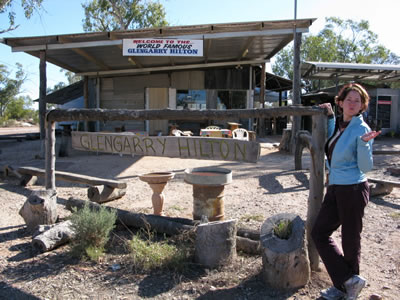
|
|
The Glengarry "Hilton."
|
|
Lightning Ridge sparked our creativity, ingenuity, and zest for life. My boyfriend caught opal fever and almost purchased a small plot (they are surprisingly inexpensive) to carve out his own path to riches, as so many people before him have done — or at least tried to do. His desire was quelled after promises that we could return after seeing more of Australia first. He has not forgotten about that promise, and neither have I.
Accommodations in Lightning Ridge
In Lightning Ridge you will find a variety of hotels, motels, B&Bs, caravan parks, and even a homestead or two to stay at. Camping starts at $12/night, and most accommodation is easily under $100/night.
|
Nora Dunn is a Professional Hobo and freelance writer, traveling the world full-time in search of out-of-the-way eclectic destinations like Lightning Ridge to capture — and inspire — her imagination.You can follow her adventures at www.theprofessionalhobo.com.
|
